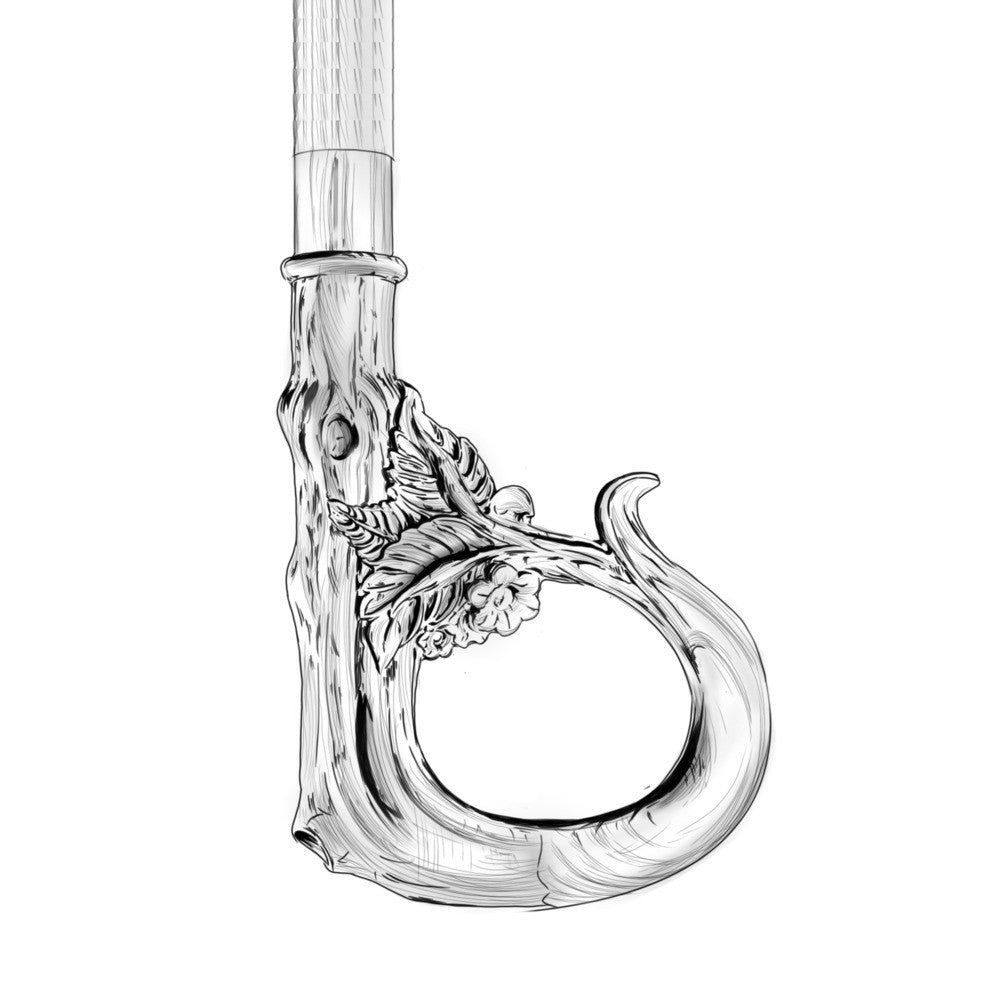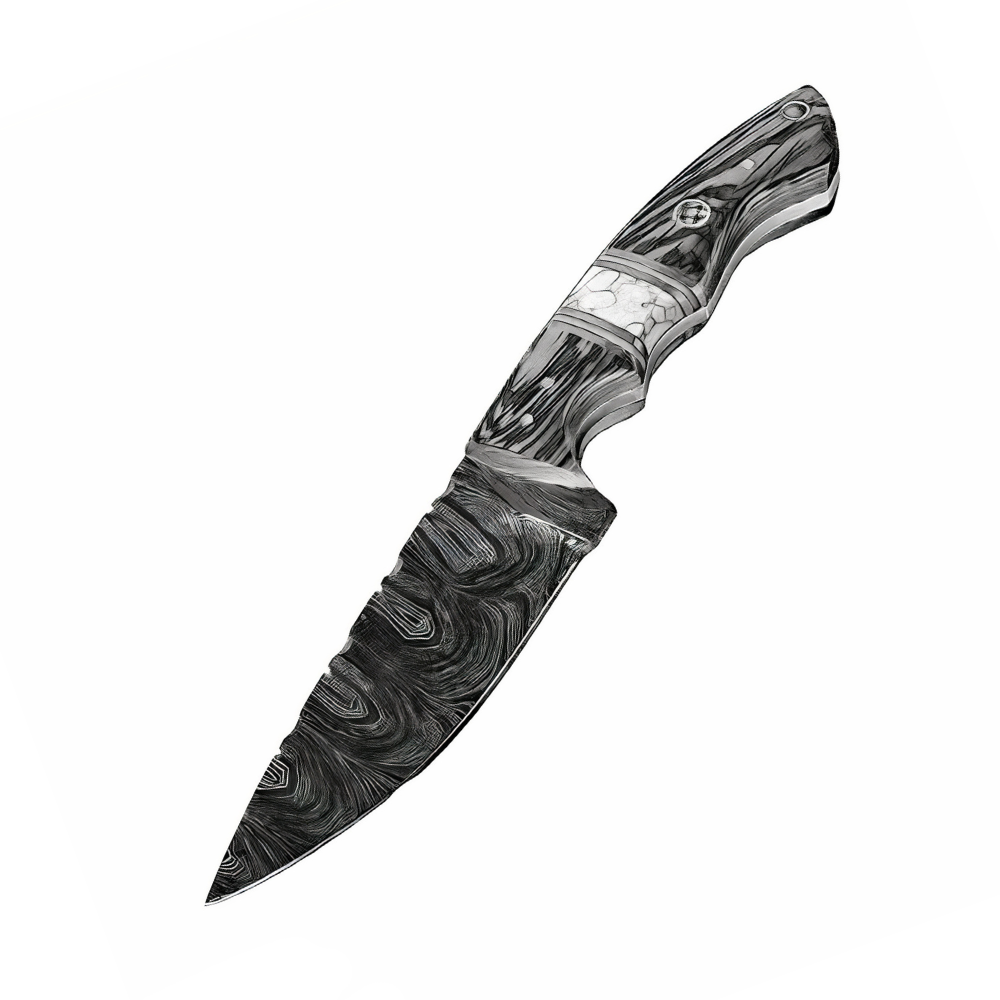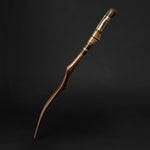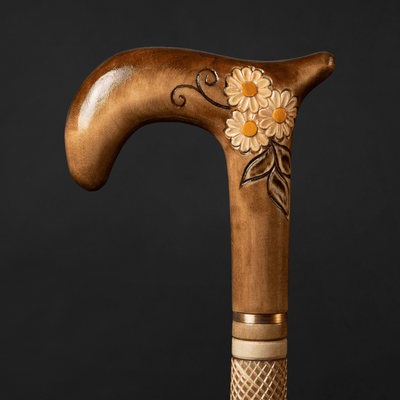You have no items in your shopping cart.
Recent Posts
-
The Art of Christmas Design: Walking Canes That Celebrate the Season in Style
-
How an Ergonomic Walking Cane Handle Prevents Hand and Wrist Strain?
-
How to Walk With a Cane Correctly to Avoid Back or Shoulder Strain?
-
5 Common Mistakes People Make When Buying a Walking Cane (and How to Avoid Them)
-
How to Choose a Walking Cane That Reflects Your Personality (Not Just Your Needs)?
-
Walking Canes That Match Formalwear for Weddings and Events
MOST POPULAR NOW
03
May
We all know that proper disposal of waste is important for the environment. However, when it comes to disposing of walking sticks, many people are unaware of the impact that improper disposal can have on the environment.
Walking sticks are a common sight on hiking trails, parks, and other outdoor areas. They provide stability and support to those who need them, allowing them to enjoy the outdoors safely. However, when these walking sticks reach the end of their useful life, they must be disposed of properly to minimize their impact on the environment.
How to properly dispose of your old walking stick: recycling and reusing tips?
The environmental impact of improper disposal
When walking sticks are improperly disposed of, they can end up in landfills or the natural environment, where they can cause significant harm. Walking sticks are often made of wood, which can take years to decompose. As they decompose, they release methane, a potent greenhouse gas that contributes to climate change.
In addition, walking sticks can also pose a threat to wildlife. Animals can become entangled in them, leading to injury or death. If walking sticks are left in the natural environment, they can also disrupt the natural balance of ecosystems by providing an unnatural source of material for organisms that would not normally have access to it.

Proper disposal of walking sticks
To minimize the environmental impact of walking sticks, it is important to dispose of them properly. Here are some tips for proper disposal:
-
Recycling: Walking sticks made of metal or plastic can often be recycled. Check with your local recycling center to see if they accept these materials.
-
Composting: If your walking stick is made of wood, it can be composted. However, it is important to remove any metal or plastic parts first.
-
Donation: If your walking stick is still in good condition, consider donating it to a charity or organization that can put it to good use.
-
Disposal: If your walking stick cannot be recycled, composted, or donated, it should be disposed of in the regular trash. However, it is important to break it down into smaller pieces to minimize its impact on the environment.
In conclusion, proper disposal of walking sticks is important to minimize their impact on the environment. When walking sticks are improperly disposed of, they can release methane and harm wildlife. To minimize the environmental impact, walking sticks should be recycled, composted, donated, or disposed of properly. By following these tips, we can all do our part to protect the environment.
Recycling tips
Researching local recycling programs
When it comes to proper disposal of walking sticks, it's important to know the local recycling programs available in your area. Recycling programs can help ensure that walking sticks are disposed of properly and can be repurposed in a sustainable way. In this article, we'll discuss how to find local recycling programs for walking sticks and questions to ask these programs.
Finding local recycling programs
The first step in finding local recycling programs for walking sticks is to check with your local government. Most cities and towns have recycling programs in place, and these programs will often accept walking sticks. You can check your local government's website or contact them directly to find out more information.
Another way to find local recycling programs is to check with recycling centers in your area. Many recycling centers will accept walking sticks, and they may even have specific guidelines for how to dispose of them properly. You can search online for recycling centers in your area, or check with your local waste management company to find out where to recycle walking sticks.
Questions to ask recycling programs
Once you've found local recycling programs, it's important to ask the right questions to ensure that your walking sticks are disposed of properly. Here are some questions to ask recycling programs:
-
What materials do you accept for recycling? It's important to make sure that the recycling program accepts walking sticks before bringing them in.
-
Are there any specific guidelines for how to prepare walking sticks for recycling? Some recycling programs may require walking sticks to be broken down into smaller pieces, for example.
-
What happens to the walking sticks after they are recycled? It's important to know how the walking sticks will be repurposed to ensure that they are being disposed of in a sustainable way.
-
Are there any fees associated with recycling walking sticks? Some recycling programs may charge a fee for recycling certain materials, so it's important to know if there are any costs associated with recycling walking sticks.
In conclusion, finding local recycling programs for walking sticks is an important step in ensuring that they are disposed of properly and sustainably. You can check with your local government or recycling centers in your area to find out where to recycle walking sticks. When contacting recycling programs, be sure to ask questions about what materials they accept, any specific guidelines for recycling walking sticks, what happens to the walking sticks after they are recycled, and if there are any fees associated with recycling. By taking these steps, you can do your part to protect the environment and ensure that walking sticks are disposed of properly.
Preparing your walking stick for recycling
When it comes to recycling your walking stick, it's important to prepare it properly before bringing it to a recycling center. Proper preparation can ensure that your walking stick is accepted for recycling and can be repurposed in a sustainable way. In this article, we'll discuss how to prepare your walking stick for recycling, including cleaning it and removing non-recyclable parts.
Cleaning your walking stick before recycling
Before recycling your walking stick, it's important to clean it properly. This can help ensure that the walking stick is free of any dirt, debris, or other contaminants that could make it difficult to recycle. Here's how to clean your walking stick:
-
Start by wiping down the walking stick with a damp cloth to remove any dirt or debris.
-
If there are any stubborn spots, you can use a mild soap or cleaning solution to help remove them.
-
Once you've cleaned the walking stick, rinse it thoroughly with water to remove any remaining soap or cleaning solution.
-
Finally, dry the walking stick with a clean towel to remove any excess moisture.
Removing non-recyclable parts
In addition to cleaning your walking stick, it's also important to remove any non-recyclable parts before bringing it to a recycling center. This can help ensure that the walking stick is accepted for recycling and can be repurposed in a sustainable way. Here are some non-recyclable parts to look for:
-
Rubber or plastic tips: Many walking sticks have rubber or plastic tips that are not recyclable. These should be removed before recycling the walking stick.
-
Metal hardware: Some walking sticks have metal hardware, such as screws or bolts, that may not be recyclable. These should be removed before recycling the walking stick.
-
Decorative elements: If your walking stick has any decorative elements, such as beads or tassels, that are not made of recyclable materials, these should be removed before recycling.
By removing non-recyclable parts, you can help ensure that your walking stick is accepted for recycling and can be repurposed in a sustainable way.
In conclusion, preparing your walking stick for recycling is an important step in ensuring that it is disposed of properly and sustainably. To prepare your walking stick for recycling, be sure to clean it thoroughly and remove any non-recyclable parts, such as rubber or plastic tips, metal hardware, or decorative elements. By taking these steps, you can do your part to protect the environment and ensure that your walking stick is repurposed in a sustainable way.
Types of recyclable materials
Walking sticks can be made from a variety of materials, some of which can be recycled while others cannot. In this article, we'll discuss the types of materials that can be recycled from walking sticks and what to do with non-recyclable materials.
Types of materials that can be recycled from walking sticks
-
Wood: Many walking sticks are made from wood, which is a recyclable material. The wood can be chipped into mulch or used for other wood products.
-
Metal: Walking sticks can also be made from metal, such as aluminum or steel, which are both recyclable materials. The metal can be melted down and used to make new products.
-
Rubber or plastic: While not all rubber or plastic parts of walking sticks are recyclable, some types are. For example, some rubber or plastic tips on walking sticks can be recycled, depending on the type of material and the recycling program.
What to do with non-recyclable materials?
Not all parts of a walking stick can be recycled. Here are some non-recyclable materials that may be found on walking sticks and what to do with them:
-
Leather: Many walking sticks have leather handles or straps, which are not recyclable. However, they can be repurposed or donated to a thrift store or charity.
-
Decorative elements: Some walking sticks have decorative elements, such as beads or tassels, that are not made of recyclable materials. These can be removed and repurposed or donated.
-
Non-recyclable rubber or plastic: If the rubber or plastic parts of a walking stick cannot be recycled, they should be disposed of properly according to local waste management regulations.
By properly disposing of non-recyclable materials, we can reduce waste and minimize our impact on the environment.
In conclusion, walking sticks can be made from a variety of materials, some of which can be recycled while others cannot. Wood and metal are recyclable materials that can be repurposed into new products. Rubber or plastic tips on walking sticks may also be recyclable depending on the type of material and recycling program. However, leather handles or straps and non-recyclable rubber or plastic parts should be disposed of properly according to local waste management regulations. By properly disposing of non-recyclable materials and recycling what we can, we can reduce waste and help protect the environment.
Donating your walking stick for recycling
If you have a walking stick that you no longer need or want, you may be wondering what to do with it. One option is to donate it for recycling. In this article, we'll discuss organizations that accept donated walking sticks for recycling and what happens to them.
Organizations that accept donated walking sticks for recycling
-
Local recycling centers: Many local recycling centers accept walking sticks for recycling. Check with your local center to see if they accept walking sticks and what their requirements are.
-
Non-profit organizations: There are non-profit organizations that accept donated walking sticks for recycling. One example is the Accessible Icon Project, which aims to create a more accessible world by promoting the use of the Accessible Icon. This organization accepts walking sticks and canes for recycling and repurposing.
-
Thrift stores: Some thrift stores accept walking sticks for resale or donation. While they may not necessarily recycle them, donating them to a thrift store can give them a second life and keep them out of the landfill.
What happens to donated walking sticks?
When you donate your walking stick for recycling, it may be repurposed or recycled depending on the organization you donate it to. Here are some potential outcomes:
-
Repurposing: Some organizations may repurpose the walking stick for a new use. For example, it could be turned into a piece of furniture or used for art projects.
-
Recycling: Walking sticks made from recyclable materials like wood or metal may be recycled. The material can be melted down and used to make new products.
-
Resale: If you donate your walking stick to a thrift store, it may be resold or donated to someone in need. This can give it a second life and prevent it from going to the landfill.
In conclusion, if you have a walking stick that you no longer need or want, donating it for recycling is a great way to reduce waste and give it a second life. Many local recycling centers, non-profit organizations, and thrift stores accept walking sticks for recycling or repurposing. When you donate your walking stick, it may be repurposed, recycled, or resold, depending on the organization you donate it to. By donating our walking sticks, we can help protect the environment and support organizations that are working to make the world a better place.
Reusing tips
Finding creative ways to reuse your walking stick
Walking sticks are not only useful tools for mobility, but they can also be repurposed and reused in creative ways. In this article, we'll discuss some ideas for reusing walking sticks around the house and tips for decorating and repurposing them.
Ideas for reusing walking sticks around the house
-
Decorative accents: Walking sticks can be used as decorative accents around the house. You can place them in a vase, lean them against a wall, or hang them on a hook for a rustic look.
-
Curtain rods: Walking sticks can be used as curtain rods for a unique and rustic touch to any room. Simply attach brackets to the wall and slide the walking stick through the curtains.
-
Coat rack: Use a walking stick as a coat rack by attaching hooks or knobs to it. This is a great way to add a unique touch to your entryway or mudroom.
-
Garden stakes: Walking sticks can be used as garden stakes to help support plants or as a decorative element in your garden.
-
Lamp base: Use a walking stick as the base for a DIY lamp. This is a great way to create a one-of-a-kind piece for your home.
Tips for decorating and repurposing walking sticks
-
Clean and sand: Before repurposing your walking stick, make sure to clean and sand it. This will help remove any dirt or debris and create a smooth surface for decorating.
-
Paint or stain: You can paint or stain your walking stick to give it a new look. Use a color that complements your existing decor or go for a bold pop of color.
-
Add accents: You can add accents like beads, ribbon, or twine to your walking stick for a unique touch. This is a great way to customize your walking stick and make it your own.
-
Repurpose non-recyclable parts: If your walking stick has non-recyclable parts, consider repurposing them for other projects. For example, the rubber tips can be used as furniture leg protectors.
In conclusion, walking sticks can be repurposed and reused in creative ways around the house. Ideas include using them as decorative accents, curtain rods, coat racks, garden stakes, or lamp bases. Before repurposing your walking stick, make sure to clean and sand it and consider painting, staining, or adding accents. By reusing and repurposing our walking sticks, we can reduce waste and add a unique touch to our homes.
Donating your walking stick for reuse
Donating your walking stick for reuse can be a great way to give it a new life while also benefiting someone in need. If you have a walking stick that you no longer use or need, consider donating it to an organization that accepts donations for reuse. In this article, we will discuss some organizations that accept donated walking sticks and what happens to them after donation.
Organizations that accept donated walking sticks for reuse
One organization that accepts donated walking sticks for reuse is the Amputee Coalition. They accept gently used walking sticks and canes, as well as other mobility equipment, to help individuals with limb loss or limb difference. The organization also accepts financial donations to help support their mission.
Another organization that accepts donated walking sticks for reuse is the Goodwill. They accept a wide variety of items for donation, including walking sticks and other mobility equipment. The organization then resells these items in their stores, with proceeds going to fund job training and employment services for individuals with disabilities and other barriers to employment.
The Salvation Army is another organization that accepts donations of walking sticks for reuse. They accept gently used walking sticks and other mobility equipment, as well as other household items and clothing. Donations are sold in their stores to fund the organization's mission of providing assistance to individuals in need.
What happens to donated walking sticks?
After you donate your walking stick for reuse, it will likely go through a process of inspection, cleaning, and repair if necessary. Some organizations may also refurbish the walking stick to ensure it is in good condition before it is sold or given to someone in need.
Once the walking stick is ready, it may be sold in a thrift store or other resale shop, given to an individual in need through a donation program, or used in a charitable event. Regardless of how the walking stick is reused, it will be given a new life and continue to be useful to someone who needs it.
Donating your walking stick for reuse is a great way to give it a new life and benefit someone in need. By donating to organizations like the Amputee Coalition, Goodwill, and the Salvation Army, you can be sure that your walking stick will be put to good use. After donation, the walking stick will go through a process of inspection and cleaning before being sold or given to someone in need. Consider donating your walking stick today and help make a difference in someone's life.
Selling your walking stick
Walking sticks can be valuable items that people collect for a variety of reasons, such as for hiking or as decorative pieces. If you have a walking stick that you no longer need or want, you may be able to sell it for a fair price. Here are some tips for selling your walking stick online or in-person:
-
Research the value: The value of a walking stick can vary greatly depending on factors such as age, condition, material, and craftsmanship. Researching similar walking sticks that have been sold recently can give you an idea of what a fair price would be for yours.
-
Determine where to sell: There are many places where you can sell your walking stick, such as online marketplaces like eBay or Etsy, specialty antique stores, or even at a local flea market or craft fair.
-
Take good photos: When selling your walking stick online, it's important to take clear, detailed photos that show its features and any imperfections. This will help potential buyers make an informed decision and can increase your chances of selling it.
-
Write an accurate description: Along with photos, a detailed description of your walking stick is important when selling online. Include information about its age, material, condition, and any unique features that may make it more valuable.
-
Price it fairly: Pricing your walking stick too high can deter potential buyers, while pricing it too low can result in a loss of value. Consider the research you have done on the value of similar walking sticks and aim for a fair price.
-
Market it effectively: Whether you are selling your walking stick online or in-person, effective marketing can increase your chances of finding a buyer. Share your listing on social media or in relevant online forums or groups, and consider creating eye-catching posters or flyers if selling in-person.
In conclusion, selling your walking stick can be a great way to give it a new life and make some extra money. By researching its value, taking good photos, writing an accurate description, pricing it fairly, and marketing it effectively, you can increase your chances of finding a buyer and getting a fair price for your walking stick.

Upcycling your walking stick
Upcycling is the process of taking something old or used and turning it into something new and useful. Walking sticks, in particular, can be transformed into a variety of different items through the art of upcycling. This not only gives your old walking stick a new lease on life but also helps reduce waste and promotes sustainability. Here are some ideas for upcycling your walking stick:
-
Decorative wall art: One of the simplest and most popular ways to upcycle a walking stick is to turn it into a decorative piece of wall art. Simply sand down the stick to remove any rough edges and varnish it for a smooth finish. Then, attach a hook to the top of the stick and hang it on your wall as a unique and eye-catching decoration.
-
Coat rack: Another practical use for an upcycled walking stick is to turn it into a coat rack. You can do this by attaching hooks or knobs to the stick at various intervals, providing ample space for hanging coats, hats, scarves, and other items.
-
Lamp base: A walking stick can also be transformed into a unique lamp base. You can either purchase a lamp-making kit or repurpose an old lamp to fit the walking stick. Sand the stick smooth and attach a lampshade to the top for a truly one-of-a-kind lighting fixture.
-
Plant stand: For the nature-lovers out there, an upcycled walking stick can be turned into a charming plant stand. Cut off the top of the stick at a slant and sand it down to a smooth finish. Then, drill a hole in the center and add a plant pot to create a natural-looking and rustic plant stand.
-
Furniture legs: Walking sticks can also be used as replacement legs for furniture. Simply sand down the stick to the desired length and attach it to the bottom of a piece of furniture using screws or brackets.
These are just a few of the many ways that you can upcycle your old walking stick. When it comes to upcycling, the possibilities are truly endless. With a little creativity and some basic DIY skills, you can transform your walking stick into something new and exciting.
Conclusion
Walking sticks are great companions for outdoor enthusiasts, but when they reach the end of their useful life, it is important to dispose of them properly. Recycling, donating, and upcycling are all sustainable options for giving your walking stick a new purpose and keeping it out of the landfill.
Throughout this article, we have explored various ways to dispose of your walking stick sustainably. We discussed the environmental impact of improper disposal, how to find local recycling programs, preparing your walking stick for recycling, types of recyclable materials, donating your walking stick for recycling or reuse, selling your walking stick, and upcycling your walking stick.
Key takeaways
- Improper disposal of walking sticks can have negative environmental impacts.
- Recycling, donating, and upcycling are all sustainable ways to dispose of walking sticks.
- Local recycling programs can be found through online research or by contacting your local waste management department.
- Before recycling your walking stick, make sure to clean it and remove any non-recyclable parts.
- Materials that can be recycled from walking sticks include aluminum, steel, and wood.
- Donating your walking stick to organizations such as the Elderly Instruments Foundation or the National Center for Equine Facilitated Therapy can provide it with a new purpose.
- Selling your walking stick online or in-person can be a great option, but be sure to consider pricing and marketing.
- Upcycling your walking stick into something new and creative can be a fun and sustainable way to give it a new purpose.
Final thoughts
As outdoor enthusiasts, we know the importance of preserving the environment for future generations. By taking simple steps to dispose of our walking sticks sustainably, we can reduce our impact on the planet and contribute to a more sustainable future. Whether it's recycling, donating, selling, or upcycling, there are many ways to give your walking stick a new purpose and keep it out of the landfill.
Thank you for reading, and we hope this article has provided you with valuable insights and ideas for sustainable walking stick disposal.
FAQs
Can I recycle my walking stick with other household recyclables?
This depends on the materials that your walking stick is made of. Some materials commonly found in walking sticks, such as wood and metal, can usually be recycled with other household items. However, other materials like rubber or plastic may require special recycling processes. It's always best to check with your local recycling program to see what materials they accept.
Are there any safety concerns when disposing of walking sticks?
Yes, it's important to take safety precautions when disposing of walking sticks. If your walking stick has a sharp metal tip or any other sharp edges, be sure to wrap it in tape or another protective material before disposing of it to prevent injury to waste handlers.
Can I reuse a walking stick that has been broken or damaged?
Depending on the extent of the damage, it may be possible to repair or repurpose a broken or damaged walking stick. If the damage is minor, such as a loose handle or a small crack, it may be fixable. However, if the damage is more severe, it may be best to recycle or upcycle the walking stick instead.
Is it better to donate or sell my old walking stick?
This depends on your personal preference and the condition of your walking stick. If your walking stick is in good condition and can be used by someone else, donating it to a charity or organization that accepts walking stick donations is a great option. If your walking stick is valuable or collectible, selling it may be a better choice. However, if your walking stick is damaged or unusable, recycling or upcycling it may be the best option.
Also Purchased
-
Beige Walking Cane for Ladies Chamomile Flower, Wooden Walking Stick
Introducing our beautiful Beige Walking Cane for Ladies with Chamomile Flower, a Wooden Walking Stick that is hand carved and handmade, making it both pretty and unique. This walking cane...$90.00$79.50 -
Exotic Burl Wood Walking Cane – Fashionable Artisan Stick
A sculptural statement in deep, oceanic blue — this walking cane is more than a support accessory, it's wearable art. Meticulously hand-shaped from stabilized burl wood, the handle evokes the...$425.00 -
ArtWalkingSticks™ MAGIC Walking Cane, Handmade - Make to Order
This piece of art is created for those who value details. We make one of a kind, handcrafted wood and resin canes. Our Wooden Canes are completely unmatched in creativity....$430.00 -
Umbrella with Eagle Handle, Fashion Umbrella For Men
Make a bold and fashionable statement with our Umbrella with Eagle Handle - a unique and functional accessory designed for men. The striking eagle handle is the highlight of this...$325.00 -
Fashionable Lion Shoehorn Long Handle, Pearly Brown Shaft, Handmade
Introducing our Fashionable Lion Shoehorn, a handcrafted, long-handled shoe horn with a pearly brown shaft that's both stylish and practical. The intricate Lion design adds a touch of elegance to...$240.00 -
ArtWalkingSticks™ MAGIC Red Walking Cane - Unisex, Handmade
This piece of art is created for those who value details. We make one of a kind, handcrafted wood and resin canes. Our Wooden Canes are completely unmatched in creativity....$425.00
































